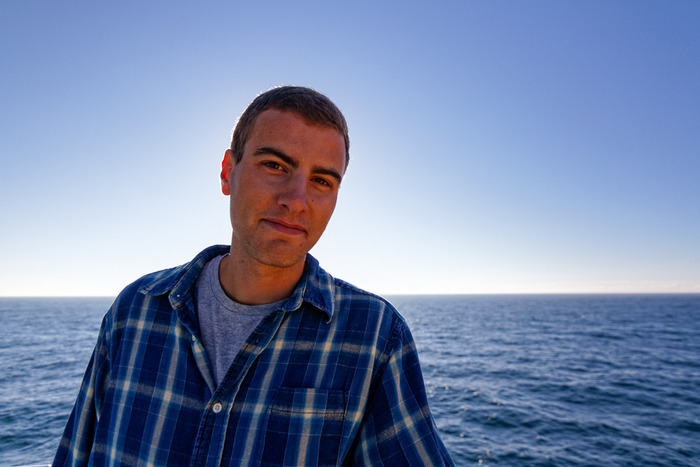September 10, 2014
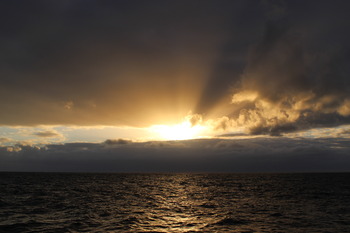 We have arrived at the last day of Leg 4 of the VISIONS ’14 cruise. We were originally scheduled to arrive back at the NOAA dock in Newport tomorrow (the 11th) at around 10:00am, but our unexpected efficiency and success on this leg has allowed us to return today around 14:30! We accomplished more work on this leg than was planned. We are currently at the 80-meter Oregon Shelf site conducting our last ROPOS dive of this leg, less than 10 miles due west of Newport. The city’s lights flicker in the distance as dawn approaches.
We have arrived at the last day of Leg 4 of the VISIONS ’14 cruise. We were originally scheduled to arrive back at the NOAA dock in Newport tomorrow (the 11th) at around 10:00am, but our unexpected efficiency and success on this leg has allowed us to return today around 14:30! We accomplished more work on this leg than was planned. We are currently at the 80-meter Oregon Shelf site conducting our last ROPOS dive of this leg, less than 10 miles due west of Newport. The city’s lights flicker in the distance as dawn approaches.
The last few days have been very eventful. Yesterday I decided to change my schedule up, so I didn’t go to bed after my watch ended at 4 am. I stayed up, hung out, and worked on my project instead. I got to eat breakfast and watch a gorgeous sunrise unfold off the starboard side of the ship. First an orange blob emerged from behind the coast mountains of Oregon, but it hid behind a cloud layer after a couple minutes, only to re-emerge through a hole in these clouds after another 15 minutes or so. Photos were captured by many, as many more sampled water from a recent CTD cast. At 10:30am I went to bed and slept until dinner. Well-rested, I enjoyed some tasty steaks cooked medium-rare, then we all met in the library for the traditional poetry night. I was enthralled with the poems and stories that were shared by chief scientists, students, and crew alike. I took a leap of faith and showed my most recent Yachats wave video edit using the projector, followed by a poetry reading of my personal masterpiece, To The Churn. Nervousness took over and sweat beaded on my forehead, but I know how I respond to situations like this and I don’t let it hinder my performance very much. I had never shared those personal creations with a group of people before, so it was new and somewhat uncomfortable. But I really wanted to show this wonderful group of people a brief insight into my strongest passion, so I did. And it was well received.
My video project is done except for background music, but I’ve already picked out the tune and given Ed the info he needs to cut a section for me. Because of our earlier port call, we are giving our final presentations today at 10:00am. So as of now, my plan is to finish writing this blog and put it on Cruiseshare, watch and photograph the sunrise, eat breakfast, and perhaps nap for a couple hours before showing my video. Over and out!
September 6, 2014
The science party has daily watch sessions in the ROPOS control room. For a four-hour block each day, two people must be present whenever there is a dive in progress, in order to log every event that occurs and take photos of biology and instrument setups. This is a very important job because it allows us to easily return to the logs to look up information about past dives, such as when this cable was plugged into that junction box, or what time this crazy jellyfish was sighted. My watch is from midnight to 4am, and can be a very different experience depending on the activities going on during the dive. Last night I wrote a couple short pieces that contrast the two extremes of nighttime watches.
A boring watch:
I sit with an artificial glow illuminating the room. Twenty screens and monitors are staring at me. It’s 1am, and I feel almost as if I’m asleep, but I’m not. I blink less often. I can feel the heat emanating from the screen in front of me as it contrasts with the cool marine air wafting in from the open hatch behind me. There are seven or eight people in this small room, but the only audibles are infrequent mumblings from the ROPOS crew and the endless hum of the ship. ROPOS sits idle on the bottom of the ocean, waiting for the next task to begin. Three hours later, nothing has changed, and the next watch group takes over for the rest of the night. Time to rest my singed and tired eyes…
An exciting watch:
I sit at my station with the glow of twenty screens and monitors beaming into my eyes. It’s 1am, and the ROPOS control room is bustling and lively. Every few minutes there’s a different combination of people in the room. Observers come and go, and John Delaney checks in on the progress of his brainchild. But the few people who are working the dive sit in their chairs, manning the ROV, operating the manipulators and logging every event and interesting biological sighting. A group of lingcod hangs around in the artificially produced shadows of the primary node 1D, seeming to challenge ROPOS’s presence in their newfound home. A pink and purple sun star spreads its many arms across the bright yellow surface, and a cluster of anemones and babysitter snails lives in symphony atop the structure. Meanwhile ROPOS makes an important cable connection into PN1D, and the cable ship operator’s voice blares throughout the room stating that the connection is sound and things are functioning correctly. Suddenly, it’s 4am and the new watch group begins their observations. Time for some well-deserved sleep…
September 3, 2014
Time for some updates! The weather has picked up a fair bit lately, generating heavier seas and clear, windy atmospheric conditions. The biggest waves splash off the bow forcefully as we transit back to Hydrate Ridge. The local wind waves ricochet off the ship and collide with the next incoming wave, throwing spray into the air. A distant whale spouts mist into the golden sun rays of the early evening. It’s a nice, choppy evening on the Thompson.
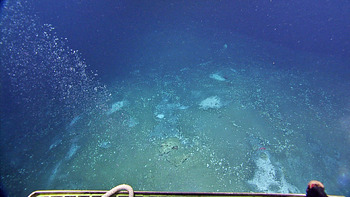
Continuing with our daily 14:00 lecture schedule, yesterday we heard a talk from Skip Denny, the “weather nut” on board. He discussed with us the dangers, causes, and effects of harsh weather at sea, telling stories of his times in the Bering Sea and describing many a weather map. Then today, we heard from Rick Berg and Brendan Phillips about methane hydrates. Together they painted us a picture of what, where, when, why, and how methane hydrates form, and who is interested in studying them. If you don’t know, methane hydrates are essentially a methane molecule trapped in a cage of water molecules when they freeze. The substance looks like dirty ice, but contains vast amounts of carbon that is released to the surrounding ocean upon melting. Hydrate Ridge is a locality off our coast where hydrates are dissociating, and methane bubbles are being released from the sediments into the bottom layers of the ocean. Because atmospheric methane has a much higher capacity to absorb solar radiation than carbon dioxide, it is important to understand it, and to understand if/when submarine methane plumes actually affect atmospheric levels. Hydrate Ridge is one of the important locations where cabled sensors, instruments, and cameras are being installed on the seafloor as a part of the RSN project.
As far as my project goes, I spoke with Deb Kelley and decided on a video project that covers a single ROPOS dive, from prep to finish. I’ll use some clips that Ed (the media guy on board) provides, and speak about each part of the dive process briefly. The idea is to provide a timeline of a typical dive, pair excellent video footage with informative narration, and make the video easily accessible to the general public; you won’t need to be an oceanographer to follow along and learn. Apparently no one has created a similar video before, so I’m excited to fill that void and work on my editing skills. Ed is going to give me a tutorial for Final Cut Pro and provide me with video clips, and I’ll take it from there. We have reached the halfway point for this cruise, so it’s time to get going on this!
August 31, 2014
After a delicious catfish dinner and another nice sunset (albeit not as good as the one 3 days ago), I sit at my computer in the main lab working on media-related tasks. These are not directly related to my Visions ’14 project, however they allow me to practice using the tools that will ultimately help me create my project video. I finally got around to editing together a bunch of GoPro footage from spring break in Yachats last year, when I went for a brief vacation with a good friend from UW and her then-boyfriend. I made many timelapses, shot footage of us playing in the waves, and set my camera on a tripod in the direct path of some serious splashes (it was knocked over by waves on multiple occasions). The bummer: GoPro’s free editing program can’t import .mp3 files, meaning 90% of my music is out of the question. I’ve found there’s always something less-than-ideal when dealing with technology and making videos. I also took a timelapse video of tonight’s sunset from the bow of the ship, which is beautiful yet jumpy from the sped-up motion of the ship. Case in point.
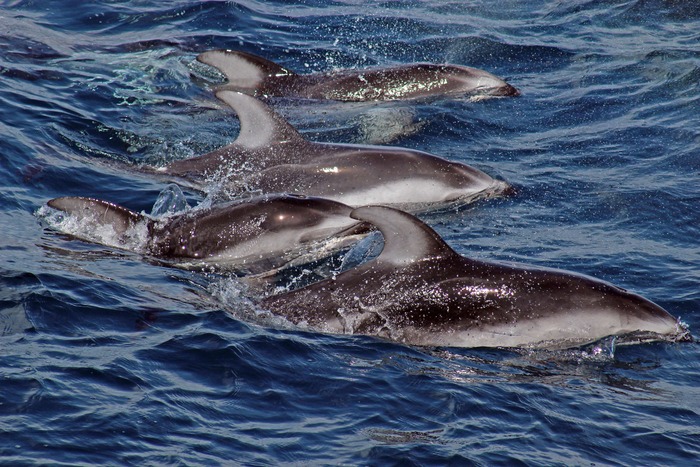
Today’s 14:00 meeting in the ship’s library was postponed until about 14:45, because John Delaney had important chief-scientist-y things to accomplish first. But from the moment he entered the room to speak to us about science, oceanography, philosophy, and life, we became a quiet and pensive audience that was very much in tune with his mood and outlook. He spoke about the history of human travel on the oceans, from the Vikings to explorers like Captain Cook to the indigenous peoples that populated Australia and the South Pacific Islands from mainland Asia. He spoke about the inherent and utterly unfathomable complexity of the land-ocean-atmosphere system, which, similar to the human brain, may never be fully understood. He spoke about the desire to understand how the accretion of this planet from cosmic dust and bolides eventually led to human consciousness. And as he always does, he recited some of his favorite poems. Every time I interact with John or hear him speak about philosophical topics such as these, it makes me feel many things. I have a strongly positive outlook on life, and a desire to make the right choices so that I am happy and satisfied until the day I die. I rediscover my own personal love for poetry, especially that related to nature and the oceans. I want to be John’s friend and talk about the human experience with him often, and share stories, and seek advice. And I want the ability to enjoy every day, keep from getting bogged down by trivial things, and just relax and enjoy the show. This isn’t the most eloquent or accurate I’ve ever been when describing these types of thoughts, but you get the idea.
I now want to share two of the better wildlife photos I’ve ever taken. Yesterday after lunch, tens of porpoises were swimming and jumping around in the ship’s vicinity for quite some time, and I managed to grab these photos with my telephoto lens! In addition, the sail jellies (Vallela vallela) were back in huge numbers, and were getting concentrated against the side of the ship.
August 30, 2014
Last night, Myesa, Billy, and I went to the bow to stargaze. It was a clear night after the gorgeous sunset seen earlier, and the sky was stunning. You need four things for a perfect evening of stargazing: clear skies (i.e. no pollution or clouds), elevation (less atmosphere between you and the stars), lack of light pollution, and dry air (moist air is denser). This is why a clear night in the high desert is ideal. Last night we only had clear skies and no light pollution, however that didn’t stop us from witnessing a few shooting stars, passing satellites, and the Milky Way. The bow also tends to be the quietest and most peaceful place on a ship, making the experience even more enjoyable. If you’re ever feeling stressed, go take some alone time on the bow, day or night.
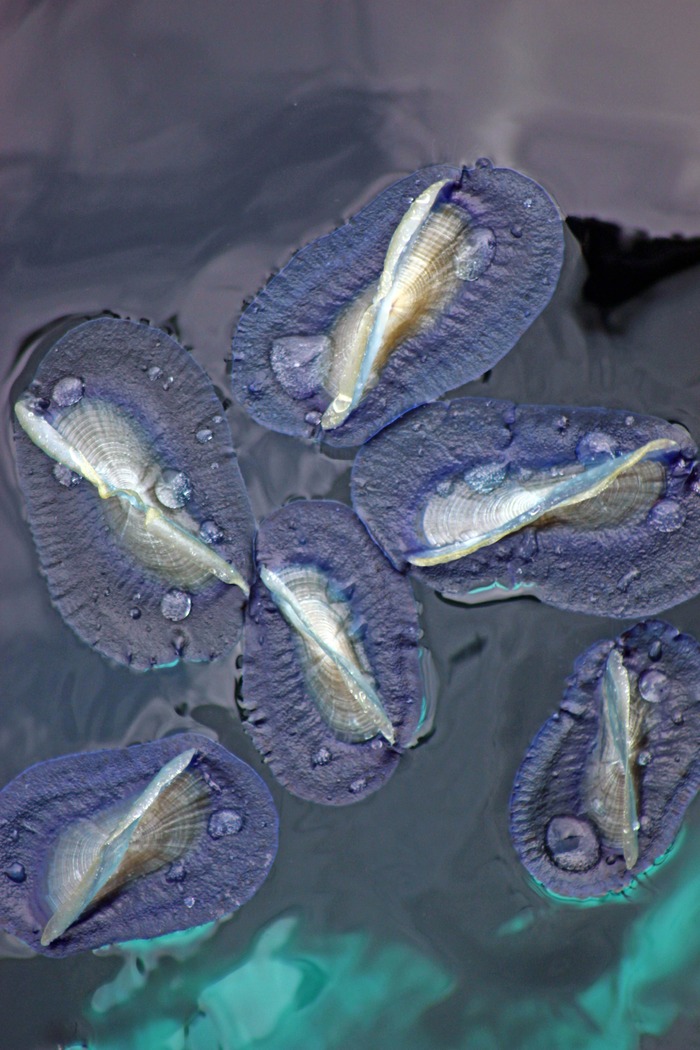
During my watch last night, one of the most important ROPOS dives took place. The Platform Interface Assembly (PIA) was brought down to 200m, attached to the floating platform which is anchored to the seafloor via two “legs”, detached from ROPOS, and plugged in. There was applause in the control room as the difficult attachment was completed. Now, as I write this blog entry, the second critical dive is underway to attach the WSP to another 200m-deep floating platform. This is a turning point in the RSN project as a whole, and its progressing exactly as planned.
August 28, 2014
It’s a warm and calm day at the sea surface above Southern Hydrate Ridge. A gentle swell is rolling through the area as a thin, fog-like cloud layer hangs around. Earlier, I took a short walk around the ship to gaze at the waves and horizon, while ROPOS descended to the seafloor to lay another section of cable. I caught a brief glimpse of a sunfish off the port bow, a strange specimen slowly swimming solo along the surface. A pair of albatross floated together in the distance, while a few lingering sail jellies bobbed around in the currents produced by the Thompson’s bow thrusters. Yesterday, these beautiful little jellyfish were abundant. Their “sails” allow the wind to direct their motion, eventually pushing millions of them ashore where they litter beaches. During my frequent vacations to the Oregon Coast (Yachats) growing up, I remember a few years when these little guys would wash ashore in great numbers, covering the basalt rocks and coloring the breaking waves a bluish-purple hue. It has been interesting to see them out here before making landfall.
I’m somewhat upset at my lethargy and lack of inspiration for project ideas. I’m so used to being proactive and excited on research vessels that I don’t feel like myself at all. That being said, my goal is to maintain a positive attitude. I think I need to get involved, talk to people onboard, and be a part of the operations as much as possible, and that will naturally lead to inspiration. Sometimes you just need to do your thing and let inspiration come to you, instead of worrying about the fact that it’s not.
August 27, 2014
Today is our first full day at sea. We left port at 14:00 yesterday after the last-minute arrival of new materials from UW. The first ROPOS dive of Leg 4 began last night, and just ended about an hour ago, as ROPOS and an empty cable spool (ROCLS) were lifted aboard. Currently, the CTD is in the water and I’m sitting in the main lab writing this blog post and looking at the video and images I’ve taken so far. I recently received my new Canon Rebel SL1 in the mail, and have been experimenting with its capabilities. My plan is to create a short video documenting some highlights of the cruise, as well as depicting life on the Thompson. I want to shoot time lapses with my GoPro and combine those with short clips of deck work, human conversations, and ROPOS video. At this point I’m still somewhat lethargic and tired, partially from the motion of the ship and partially from my odd sleep schedule. I’m excited to feel more alert and active, but right now I just want to sit around and sleep. Time for our daily meeting at 14:00! Over and out.

